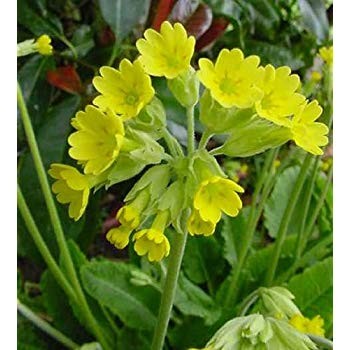Cowslip
(Primula acaulis acaulis)

Description
Primula veris, the cowslip, common cowslip, or cowslip primrose (syn. Primula officinalis Hill), is a herbaceous perennial flowering plant in the primrose family Primulaceae. The species is native throughout most of temperate Europe and western Asia, and although absent from more northerly areas including much of northwest Scotland, it reappears in northernmost Sutherland and Orkney and in Scandinavia. This species frequently hybridizes with other Primulas such as the common primrose Primula vulgaris to form false oxlip (Primula × polyantha) which is often confused with true oxlip (Primula elatior), a much rarer plant. The common name cowslip may derive from the old English for cow dung, probably because the plant was often found growing amongst the manure in cow pastures. An alternative derivation simply refers to slippery or boggy ground; again, a typical habitat for this plant. The species name veris (of spring, referring to the season) is the genitive case form of Latin "ver" (spring). However, primrose P. vulgaris, flowers earlier, from December to May in the British Isles. Other historical common names include cuy lippe, herb peter, paigle or pagil, peggle, key flower, key of heaven, fairy cups, petty mulleins, crewel, buckles, palsywort, and plumrocks. Primula veris is a variable evergreen or semi-evergreen perennial plant growing to 25 cm (10 in) tall and broad, with a rosette of leaves 5–15 cm long and 2–6 cm broad. The deep yellow flowers are produced in spring, in clusters of 10–30 blooms together on a single stem. Each flower is 9–15 mm broad. Red- and orange-flowered plants occur rarely but can be locally widespread in areas where coloured primula hybrids bloom at the same time as the native cowslip, enabling cross-pollination. The cowslip is frequently found on more open ground than the primrose, including open fields, meadows, coastal dunes, and clifftops. The plant suffered a decline due to changing agricultural practices throughout the 1970s and 1980s in Britain. It may therefore be rare locally, though where found it may be abundant. Additionally the seeds are now often included in wildflower seed mixes used to landscape motorway banks and similar civil engineering earthworks where the plants may be seen in dense stands. This practice has led to a revival in its fortunes.
Taxonomic tree:







